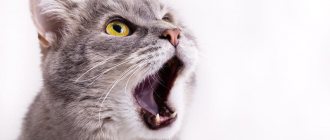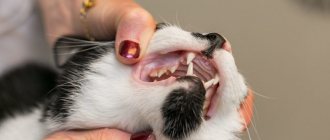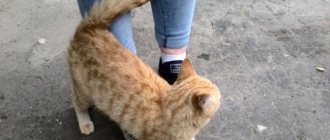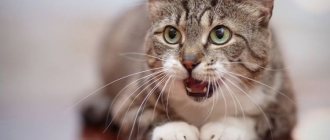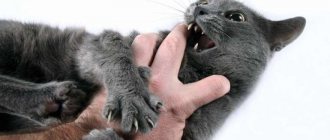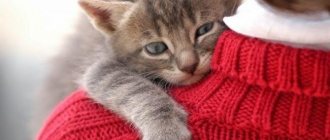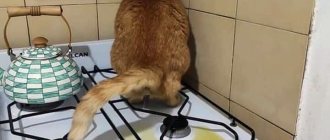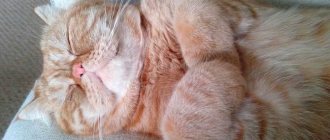Cerebellar ataxia in cats often develops as a result of congenital abnormalities of the nervous system. But sometimes the disease manifests itself as a complication of acquired pathologies. Characteristic symptoms of the disease are unsteadiness of gait, loss of coordination, and darting eyes. Treatment is carried out only after a comprehensive diagnosis and clarification of the factors that caused the disorders.
Causes of cerebellar ataxia
The main cause of impaired motor coordination in cats is infections that affect the central nervous system and brain. Most often, ataxia develops against the background of panleukopenia.
Loss of coordination is the main sign of pathology
Cerebellar ataxia in cats is a hereditary disease with a genetic predisposition or develops as a congenital form. It can appear as a result of an intrauterine developmental disorder in kittens.
Also reasons may be:
- traumatic brain injuries;
- cerebral edema;
- inflammatory processes;
- damage to the inner ear due to otitis media;
- neuritis of the craniofacial nerve;
- tumors.
Veterinarians include hernias between the vertebrae and spinal cord injuries as possible causes of incoordination in cats.
Otitis in a cat
What treatment is prescribed?
Prozerin will improve the functioning of the animal’s nervous system.
Ataxia in cats can be treated at home. If a cat throws its head back, cannot stand on its paws normally, and is very unsteady, then Proserin is prescribed to restore nerve conduction. To normalize cerebral circulation, Cerebrolysate is prescribed. Glycine will help improve the functioning of brain tissue. If the disease is caused by an infection, antibiotics Ampicillin and Vancomycin are prescribed. Cerebral edema is eliminated with diuretics, such as Furosemide and Veroshpiron.
Treatment of ataxia with physical therapy is often practiced. It is recommended to do the following procedures in courses:
- massage;
- pulse therapy;
- UHF.
Since animals with ataxia often fall when moving, sharp objects and tall furniture should be removed from the room. The distance between objects in the room should be large, this will help the animal move more confidently and not bump into obstacles. In addition to drug treatment, do not forget about your pet’s nutrition. If the cat is arched unnaturally and his head is constantly lowered to one side, you should take vitamins D, group B. To prevent the cat from vomiting due to poor coordination, the food should be easily digestible and quickly digested. It is important to keep a balanced diet, because such animals need to strengthen their immune system.
Physical development
To improve coordination of movements, the kitten can play with a special fishing rod.
In order for coordination of movements to develop as much as possible, it is useful to arrange games with the kitten, during which the animal will learn to move. A fishing rod with a rope is suitable, where you should hang a bright object, for example, a toy mouse. The toy can be moved along the floor or slightly raised above the surface. It is important to ensure that the kitten does not jump high, as if it falls, it will land poorly and be injured. Fine motor games are helpful. Pet stores sell special puzzles with objects, toys or balls hidden inside.
General group of symptoms for all types
The disease has species-typical and generally similar symptoms. The different symptoms depend on the causes. All types of pathology are characterized by:
- the cat holds its head atypically, it can tilt it to the side or lower it down;
- a staggering gait is observed, the animal loses coordination, the cat can walk, raising its hind legs high.
Epilepsy in cats: symptoms, treatment, how to stop seizures
If the animal's spinal cord is damaged, it will experience pain when walking. Such cats try to hide in a quiet place and move less.
Attention! In severe forms, paralysis of the hind limbs can develop in cats.
With cerebellar ataxia, tremor occurs when running or walking. The kitten will often tremble, and most often the trembling is noticeable only in the back of the body. The cat also has dilated pupils and poor coordination.
If the vestibular apparatus is affected, the cat will suffer from severe headaches. Such animals constantly meow, hide in the corner, pressing their foreheads against the wall.
Hind limb paralysis
The cat staggers when walking: problems with the spine
If our cat wobbles when walking and appears to have weakness in the hind neck or poor mobility of the hind legs, the problem may be of neural or even spinal origin. The cerebellum and peripheral nervous system are responsible for moving the animal, so nerve or brain problems can cause these problems.
The vestibular apparatus, which is closely connected to the ear, is responsible for balance, therefore, in addition to otitis media, another cause after unsteadiness may be damage to the vestibular system. There may also be more serious problems behind this symptom that require treatment, such as a herniated disc.
If our cat staggers when walking, there may be many different processes behind this strange gait. And although some of them may be self-limiting and can be treated on their own, most of them require the help of veterinarians to prevent our pet from getting worse.
Some of these diseases even require surgical interventions, so we recommend that you contact your trusted veterinary clinic if you notice these symptoms in your pet, as a definitive diagnosis requires various tests, which can never be done without qualifications and through the network.
Localization of damage in ataxia
Stroke in cats: symptoms and treatment, first signs
Depending on the location of the source of inflammation, the pathology is divided into the following groups:
- Cerebellar - appears with inflammation of the medulla oblongata and cerebellum. The disease can be either congenital or acquired.
- Vestibular - with inflammation of the inner ear system.
- Proprioretic - a form caused by damage to peripheral nerves.
- Spinal cord develops against the background of damage to the spinal cord.
In veterinary medicine, there are two forms of ataxia:
- static;
- dynamic.
In the first case, the kitten will not even be able to stand straight; in the second, on the contrary, coordination is impaired only during movement.
Pathology in kittens from birth
The cat cannot walk on his own and falls over on his side.
Hello, we have this problem. The cat cannot walk normally for 3-4 days; it “slides” to the left. Initially, he was limping on his left leg, it gave way inward, and now the entire left side seems to be giving out. They started visiting the doctor after Senya became lethargic and inactive. We were told that the problem was in the kidneys, we were given IVs, but the condition did not improve. Then they did an ultrasound, there was nothing wrong. To check, the doctor decided to take a picture of the lungs, it turned out that there was swelling there. Just now we stood in line for an ultrasound of the heart; it turned out that this is very problematic in Moscow. During treatment, vitamins were injected, the condition improved, the cat ate, and seemed cheerful. Then he just started limping on his left leg, we thought that the injection into the muscle was unsuccessful, since we give injections ourselves. But the doctors said it goes away quickly. For a while he began to walk normally, as usual. And then, as I said, I began to collapse. Today everything has completely worsened, he cannot walk independently, only if he is supported on the left side. Refuses to eat. He seems to be able to feel his hind legs, they even checked them with a needle. Sena is 13 years old. Please help, we are very worried about our cat!
Types of ataxia
Depending on the area of damage, there are two main types of pathology.
Sensitive ataxia (proprioceptive)
Idiopathic cystitis in cats: symptoms and treatment
This form of the disease occurs due to damage to the spinal cord or peripheral nerves. The occurrence of the disorder may be influenced by the presence of a tumor in the intervertebral discs in the cat.
The animal loses the ability to flex and extend its paws at the joints. It cannot consciously choose the direction of its movement. The cat is experiencing severe pain in the back and neck. In severe forms of the pathology, the cat cannot move completely.
Attention! If the brain is only partially damaged and treatment is given early, your pet has a chance of a full recovery.
Vestibular ataxia
The diagnosis of vestibular ataxia is made if the inner ear system is affected and there is also a tumor of the brain stem. Pets over ten years of age most often get sick. The cat cannot stand, it falls on its side. The head tilts towards the affected side. The animal moves very slowly and carefully. Vomiting is sometimes observed.
Vestibular ataxia can occur due to:
- development of a brain tumor;
- otitis media;
- infections;
- injuries when cleaning ears;
- drug overdose.
Important! The first sign of pathology is that the cat is sitting in the corner, leaning its forehead against the wall.
Signs of vestibular ataxia
The cat staggers when walking: otitis media
The balance is mainly found in the ear, and imbalances that occur in the ear or nervous system can cause ataxia, a disorder that can be the cause of the problem if our cat wobbles when walking.
Thus, we must rule out an ear infection: otitis media. Otitis media can occur for a variety of reasons, such as a buildup of mites that infect the ear.
Although mild infections and infections of the outer ear do not cause these symptoms, otitis media can become more complicated and affect the middle ear, which can lead to ataxia, which can be the cause of our pet's imbalance if our cat wobbles when walking.
These ear infections can also be caused by a blow or even a foreign body in the ear. A typical case is thorns, an unknown danger to your cat that causes severe pain and serious ear infections.
© shutterstock
Diagnosis of ataxia in a cat
The main stage in diagnosing pathology is a complete history taking. The veterinarian must determine whether the animal had injuries or whether it suffered from infectious diseases. If possible, find out information about heredity and the course of pregnancy if we are talking about pathology in a kitten.
The animal's nervous system is assessed and tests are taken to identify viral pathogens. It is recommended to do an MRI of the brain to see tumors or areas of bruising. It is necessary to examine the ears using an otoscope.
As soon as there is a suspicion that infection is occurring in the area of the brain or spinal cord, a test for leukocytes in the cerebrospinal fluid is required.
Diagnosing disease in pets
Establishing diagnosis
The cause of the disease is determined by the doctor based on clinical symptoms and a thorough history. The owner informs the veterinarian about previous injuries, nutrition, previous diseases, pedigree, information about the presence or absence of similar ailments in relatives. It is necessary to find out whether the mother cat was vaccinated before mating.
In severe cases, the cat is unable to feed itself.
To clarify the diagnosis, a veterinary neurologist is involved. They conduct tests for viral diseases of cats, ultrasound, x-rays, MRI. The ears are examined using an otoscope. If necessary, cerebrospinal fluid is collected for analysis. Blood and urine tests are performed to exclude or confirm the presence of diseases with similar symptoms.
Treatment of cerebellar ataxia in cats
The chances of recovery and treatment methods for feline ataxia depend on the general condition of the animal and the reasons that caused the development of the pathology. The cat has the opportunity to fully recover and return to a healthy lifestyle if the owner consults a veterinarian in a timely manner.
The measures taken by veterinarians when diagnosing ataxia may be as follows:
- If the pathology is caused by a tumor, surgery is used. After its removal, the symptoms disappear.
- In case of poisoning, measures are taken to relieve intoxication. The animal is prescribed IVs, injections of vitamin B1, and diet.
If the pathology occurs against the background of brain defects, it can occur in mild, moderate and severe forms. The disease cannot be cured, but in mild cases it is possible to save the kitten. This will require full-time care.
Kittens are prescribed the drug "Gamavit" to strengthen the immune system. To improve the functioning of brain tissue, Glycine is recommended at a dosage of 250 mg, 1 tablet per day. The course of admission is 14 days.
Most often, the condition stabilizes after the kitten turns one year old.
Treating a pet for poisoning
Associated symptoms
Symptoms of diseases can develop in two ways. In the first case it manifests itself immediately and in full, and in the second it manifests itself gradually with an intensifying effect. In any situation, you need to seek help from a specialist as soon as possible. Among the most common symptoms are:
- unsteady gait;
- falling on one side when walking;
- inability to move quickly;
- lack of coordination;
- uncertain behavior in space;
- fear of making a movement;
- gently stepping on one side of the paws;
- pupils of different sizes;
- shifty eyes;
- fainting;
- inadequate reaction to habitual actions;
- With epilepsy, the jaws involuntarily close, convulsions, and involuntary urination.
This behavior is justified by the animal’s fear of falling, dizziness, pain in the brain and heart, as well as in the limbs. The development of paralysis can begin as a result of damage to the body by infection, or an inflammatory process in internal organs and systems, when blood flow is disrupted. If parts of the spinal column are disturbed, then the owners often note a disturbance in the bowel movements of the bladder and intestines. The development of ataxia can be facilitated by a brain tumor, panleukopenia, chemical poisoning, and skull trauma.
Treatment is prescribed only by a veterinarian based on the diagnosis. In some cases, the animal will be indicated for inpatient treatment with injections and droppers.
Treatment on an outpatient basis and at home
It is important that therapy is carried out comprehensively. The treatment regimen is developed depending on the cause that caused the development of the disease. In this regard, the dosage of drugs may differ even if we are talking about the same form of pathology.
The following medications are most often prescribed:
- vitamin complexes, B vitamins;
- to eliminate infections - antibiotics;
- for swelling of the brain - diuretics;
- Hepatoject for liver dysfunction;
- to improve blood circulation in the brain - Cerebrolysate;
- saline solutions in droppers to relieve intoxication.
Physiotherapy and massage are recommended for the animal. If the spinal cord is affected, surgery is required.
Important! You should not try to treat yourself. A sick animal requires professional advice from a veterinarian. The severe form cannot be eliminated using folk methods alone without an integrated approach.
Vitamins for full recovery
Reasons in food
Food may also be associated with this type of process: cheap food may lack various minerals and proteins, which can cause this type of weakness.
This is why we should always take extra care when feeding our pets and finding the best cat food. The juvenile and geriatric stages are especially important, so senior pet or kitten food must be given to our pets during these life stages to avoid suffering from diseases caused by deficiency.
© shutterstock
Prevention of ataxia
Despite the complexity and severity of the pathology, pet owners can create the necessary conditions to avoid its development. First of all, it is necessary to avoid any factors that could lead to injury. It is not recommended to let your animal go outside unattended.
The following should be used as preventive measures for the development of ataxia:
- Timely contact a veterinarian if there is a suspicion that the animal has a traumatic brain injury.
- Vaccinations in accordance with the schedule against leukemia, panleukopenia.
- Treatment of inflammation in the ear canals is mandatory.
- Examine the cat for panleukopenia before mating is planned.
- During pregnancy, protect the cat from contact with other animals.
Massage for cats
Important! Loss of coordination can be effectively treated through physical therapy. Veterinarians recommend working with your pet and provoking it to play. Activity is very necessary for a kitten with ataxia.
Ataxia in cats is a complex disease, but with a competent and timely approach, the pet owner can return it to normal life. Caring and adherence to preventive measures effectively influence the healing process.
Let's sum it up
The owner of the animal must understand that causing him suffering is not the best choice. Cats are naturally very active, easy-going and playful, so the inability to control their own body becomes real torture for them. Ataxia is an incurable disease unless it is provoked by a specific factor that can be removed. Therefore, the owner of a cat suffering from ataxia has only one option - to look for an attentive and qualified doctor, conduct an examination, discuss the treatment regimen with him and monitor the pet in order to notice deterioration in time.
Help save the cat! The cat is dying.
Really need some good advice! After suffering from an illness, the cat was vaccinated some time later. After vaccination (on the 3rd day), the cat seemed to have lost his limbs (I can’t call him paralysis, because he still moves them). Side effects on the central nervous system. Stretching of the limbs as if in convulsions (the convulsions themselves are not observed, as the skier stretches out his paws and slides on the linoleum), twitching of the head while lapping up liquid, as if hiccups (but this is definitely not hiccups). The cat has been eating almost nothing for about 3 days (I feed him broth from a spoon), and goes to the toilet once every 1-2 days, “in a small way.” He doesn’t walk or sit on his own, he just lies on his side. He also has difficulty holding his head. The gaze is conscious, purrs. The doctor cannot do anything, the diagnosis is also unclear. Only the words: “I can’t say anything, all I can do is give injections and hope.” I have already stopped calling the doctor (the doctor is one of the best in the city, only good reviews). I don't want to put you to sleep. I believe that if there is even a small chance, it should be used. Help, what else can be done? Below is our entire medical history for professionals: I’ll start from the beginning: we adopted a small kitten (1-1.5 months) at an animal shelter (June 2012). The kitten turned out to be sick. A week later I lost a lot of weight, I was treated for an intestinal infection (the antiviral drug fosprenil, the immunostimulant catasal and the antibiotic I don’t remember the name of). He was cured within a week. October 2012 - the cat refused food. The reasons are unknown, we didn’t keep track, because... at that time the child was in the hospital. During the child’s injury, the cat really experienced stress, hid under the sofa and sat there for half a day. We contacted the veterinarian. The cause of the disease was never found out; a blood test was taken - everything was within the physiological norm. Treatment for about 3 weeks: fosprenil (antiviral), cobactan (antibiotic), catazal (immunostimulant). It seems that the cat has more or less come to his senses. We finished the treatment. A week later, the cat’s eyes “closed” (that is, the inner eyelid closed the eye by approximately 1/3). Back to the doctor. They said: feline herpes. We resumed fosprenil + anandin drops in the eyes and nose. We treated for 2 weeks. The cat did not feel better. Here at the clinic the head doctor (the owner of the clinic) took care of us. The cat has a temperature of 41.2 (normal 38-39). He prescribed an antibiotic (human suspension amoxiclav). Weekly blood monitoring (the blood, by the way, was normal). The cat is on the mend. The cat began to eat, play, in a word, returned to normal life. Treatment was completed on the 20th of December. After 10 days we were given an anthelmintic, and after another 10 days we were given the Multifel-4 vaccination. 2 days after vaccination, the cat seemed to be paralyzed. It felt like he was having a stroke. His legs were in convulsions, at first he walked on high, straight legs (like on stilts). I couldn’t keep my balance, I fell on my side, I could crash into a door frame, I refused to eat or use the toilet. Back to the doctor. Treatment: saline dropper + piracetam + vitamins B1, B6 alternately, + cerebrolysate (all drugs from a human pharmacy). On the 2nd day of treatment, hope was lost, but the treatment was not abandoned. On the 5th day the cat came to his senses. His joy knew no bounds. On the 7th day of illness, the cat again (out of nowhere, one might say) became ill. I pet him, give him a massage, stretch his paws, warm him up, give him injections and IVs. By the way, I have never had a more sincere and intelligent animal in my life. Can you imagine a cat playing hide and seek with a child! Despite all his illnesses, there was never any thought of abandoning him. You never expect a trick from him, he will never do dirty tricks or steal something from the sly. Every morning I wake up and every day I return from work and there is no confidence that he will wait for me...
Symptoms and diagnosis
In general, the symptoms of ataxia in cats are simple. The pet looks like a drunkard, he shakes, the cat cannot walk normally, in severe cases he falls on his side with a roar, just trying to sit down. A constant tilt of the head to one side, as well as erratic circular eye movements, are very typical. Other symptoms may vary depending on the underlying cause of the ataxia. For example, a cat “under mint” can walk with a wobbling gait with its head held high; from time to time, it shakes it and generously splashes saliva around. It looks terrible, but goes away quickly.
Your veterinarian will perform a complete physical examination of your cat. The information provided by the cat's owner is important. It is advisable to remember the following:
- Did the animal have access to household chemicals, poisons, or was deratization (rodent extermination) carried out in your home or area?
- Is there any information in your pet’s pedigree about any pathologies that the cat’s parents suffered from?
- Did the cat fall from the balcony, did it get hit by a bicycle, etc.
It is very important to remember all the cases of illness that your pet has suffered. It is advisable to tell us if you have tried to treat it yourself by “prescribing” any medications.
A blood test is very important, which will allow you to determine whether there is a deficiency of any important micro- and macroelements and vitamins. X-rays and ultrasound are also used, with the help of which tumors, the presence of parasites, and other serious problems are detected.
